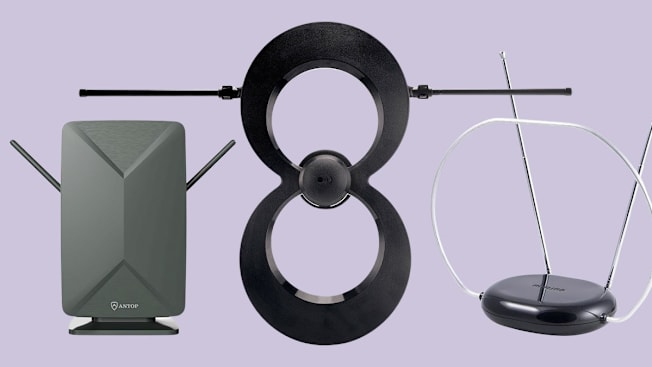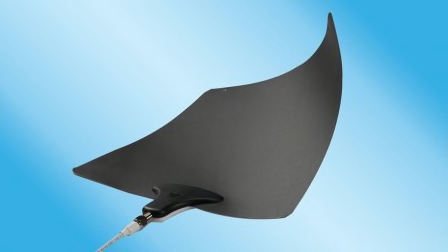Best Indoor TV Antennas, Tested and Reviewed
The right antenna will get you free TV stations and make it easier to cut the cable TV cord
When you shop through retailer links on our site, we may earn affiliate commissions. 100% of the fees we collect are used to support our nonprofit mission. Learn more.

TV antennas might seem like a relic of a bygone era, when the number of channels you received could be counted on your fingers. However, as people look for ways to trim their ever-escalating cable and streaming TV bills, digital TV antennas are making a comeback. In fact, nearly 23 million U.S. homes use an antenna to watch free over-the-air programming, according to data analytics firm Nielsen.
For our most recent test of indoor TV antennas, we used a location just north of New York City. We received dozens of free over-the-air channels. (Outdoor antennas tend to work even better.)
That’s good news for the growing number of people who are ditching traditional cable packages but retaining streaming services like Amazon Prime and Netflix. An antenna can supply their live TV, including local news and other broadcasts. (See more on the benefits of a TV antenna.)
Even if you subscribe to a cable replacement service that offers channels like AMC and HGTV, you may still want to consider using an antenna. These services—which include DirecTV Stream, Fubo, Hulu + Live TV, Sling TV, and YouTube TV—don’t always provide local programming in all markets. An indoor TV antenna can help fill that gap.
If you live near a major TV market, you’ll probably get many local stations—ABC, CBS, Fox, and NBC, plus PBS and Telemundo—using a TV antenna.
NextGen TV Signals
All antennas can receive traditional broadcast signals. However, we also verify whether antennas can receive new NextGen TV signals.
Technically known as ATSC 3.0, these signals are now available in approximately 80 percent of U.S. markets. Regardless of the antenna you use, you’ll also need a TV or converter box with an ATSC 3.0 tuner to watch ATSC 3.0 broadcasts.
Compared with traditional ATSC 1.0 broadcasts, NextGen TV can deliver brighter, sharper pictures, improved sound, and enhanced emergency notifications. It also allows for two-way interactivity, enabling features such as video-on-demand, the ability to pause or rewind to the beginning of shows, and hyper-local content, including local sports and weather reports.
Currently, most NextGen TV broadcasts are simply simulcasts of content transmitted via ATSC 1.0. However, some networks, including CBS and NBC in New York, are now offering programming with high dynamic range (HDR), which enables brighter, more vibrant images with greater contrast and richer colors.
Before you buy a new TV, check our buying guide and full TV ratings of models from all the major brands. These combine lab tests with survey results from more than 90,000 CR members.
Become a member of Consumer Reports to get access to our TV Screen Optimizer, which will help you get the perfect picture on your TV in just minutes. Join today to get started.
Tips for TV Antenna Shoppers
The antennas we tested cost about $15 to $100. As in previous tests, we found little correlation between price and performance.
The number of channels you receive will depend on your location and factors such as local topography and the placement of the antenna. In one instance, when we moved an antenna from near a window to a nearby chair, it picked up an additional 20 channels.
Over years of testing, we’ve found that the antenna that works best in one location may not be the top performer elsewhere. That means you may need to try several models, and we strongly recommend purchasing from a retailer with a no-hassle return policy.
We included a few amplified TV antennas in our review. These models have the potential to boost signal strength, helping to pull in stations that might otherwise be on the fringe. But our tests show that amplified antennas aren’t always more effective than non-amplified models. They can also amplify noise and distortion, and overpower reception from closer stations. Some amplified models actually did better with the amplifier turned off.
Also, whichever antenna you purchase, it’s a good idea to regularly rescan for channels, because you may have missed some the last time you scanned. And use our tips on where to place your antenna to get the best reception.
How CR Tests Antennas
For this year’s project, Consumer Reports tried each antenna in White Plains, NY, about 30 miles north of Manhattan. We attached the flat antennas to a window on clear days and placed one model with a different design on the windowsill. We also put each antenna outside the window on a balcony. Only one model we tried is actually rated for outdoor use, but the results were overwhelmingly better outside for every antenna. So you might consider using an indoor/outdoor model if you’re able to place or mount it outside. In general, we recommend trying a few locations to see if the reception improves.
In the rankings below, you’ll see three figures, all recorded in White Plains: the number of VHF channels received, the number of UHF channels pulled in, and the number of NextGen TV channels the antenna could get.
This year, our tests counted only the number of primary (or RF) UHF and VHF channels, such as the local ABC, CBS, Fox, and NBC stations. (Last year, our tests included both the primary broadcast channels and the digital subchannels.) In our experience, if you can receive these primary channels, you’ll also be able to get all the digital subchannels associated with them.
Receiving both UHF and VHF channels has become increasingly important. In the early days of analog TV signals, most major broadcast channels were located in the lower-frequency VHF band (channels 2 through 13); however, they are now scattered across both the VHF and UHF bands.
Most, but not all, of the antennas were able to receive at least some NextGen TV channels, which mainly use the UHF band. (A total of 11 NextGen TV channels are currently available in the wider New York City area.)
To earn a mark for reception, a station had to have a relatively stable, viewable TV picture. The amplified models in this group were tested with the amplifier turned both on and off. We gave credit to those models that had marginal reception at some moments if they were able to provide a stable, viewable picture at another time during the test.
Our test results should be useful for guiding you to models you might consider, but a number of variables, such as geography and distance from broadcast towers, can affect antenna performance in your home.




















